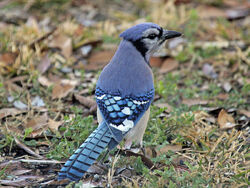| Blue Jay | |
|---|---|
 | |
| Information | |
| Range | North America |
| Scientific Classification | |
| Kingdom | Animalia |
| Phylum | Chordata |
| Class | Aves |
| Order | Passeriformes |
| Family | Corvidae |
| Genus | Cyanocitta |
| Species | Cyanocitta cristata |
| Conservation Status | |
 Least Concern | |
The Blue Jay is a species from the Cyanocitta genus. The Blue Jay (Cyanocitta cristata) is a passerine bird in the family Corvidae, native to North America. It is resident through most of eastern and central United States and southern Canada, although western populations may be migratory. It breeds in both deciduous and coniferous forests, and is common near and in residential areas. It is predominately blue with a white chest and underparts, and a blue crest. It has a black, U-shaped collar around its neck and a black border behind the crest. Sexes are similar in size and plumage, and plumage does not vary throughout the year. Four subspecies of the Blue Jay are recognized.
The Blue Jay mainly feeds on nuts and seeds such as acorns, soft fruits, arthropods, and occasionally small vertebrates. It typically gleans food from trees, shrubs, and the ground, though it sometimes hawks insects from the air. It builds an open cup nest in the branches of a tree, which both sexes participate in constructing. The clutch can contain two to seven eggs, which are blueish or light brown with brown spots. Young arealtricial, and are brooded by the female for 8–12 days after hatching. They may remain with their parents for one to two months.
The bird's name derives from its noisy, garrulous nature, and it sometimes also called a "jaybird".
Appearance
Needs Information...
Behavior
The Blue Jay can be beneficial to other bird species, as it may chase predatory birds, such as hawks and owls, and will scream if it sees a predator within its territory. It has also been known to sound an alarm call when hawks or other dangers are near, and smaller birds often recognize this call and hide themselves away accordingly. It may occasionally impersonate the calls of raptors, especially those of the Red-tailed and Red-shouldered Hawks, possibly to test if a hawk is in the vicinity, though also possibly to scare off other birds that may compete for food sources. It may also be aggressive towards humans who come close to its nest, and if an owl roosts near the nest during the daytime the Blue Jay mobs it until it takes a new roost. However, Blue Jays have also been known to attack or kill other smaller birds. Jays are very territorial birds, and they will chase others from a feeder for an easier meal. Additionally, the Blue Jay may raid other birds' nests, stealing eggs, chicks, and nests. However, this may not be as common as is typically thought, as only 1% of food matter in one study was compromised by birds. Despite this, other passerines may still mob jays who come within their breeding territories.
Diet
Blue Jays have strong black bills which they use for cracking nuts and acorns, usually while holding them with their feet, and for eating corn, grains and seeds. Its food is sought both on the ground and in trees and includes virtually all known types of plant and animal sources, such as acorns and beech mast, weed seeds,grain, fruits and other berries, peanuts, bread, meat, small invertebrates of many types, scraps in town parks, bird-table food and rarely eggs and nestlings. Blue Jays will sometimes cache food, though to what extent differs widely among individuals. Although seemingly contentious in their general behavior, Blue jays are frequently subservient to other medium-sized birds who visit bird-feeders. In Florida, Blue jays were dominated at feeders by Eastern gray squirrels, Florida Scrub-Jays, Common Grackles and Red-headed Woodpeckers, all of which were occasionally observed to aggressively prevent the jays from feeding.
Lifespan
Needs Information...
Gallery
Video

Blue Jay - HD Mini-Documentary

Bluejay Nesting Season!! Backyard Bag Feeder Proj.
Photo
Facts
- "Needs Information..."



